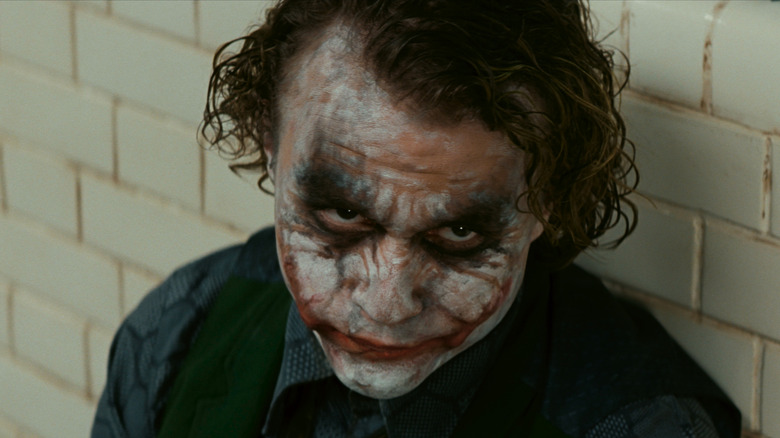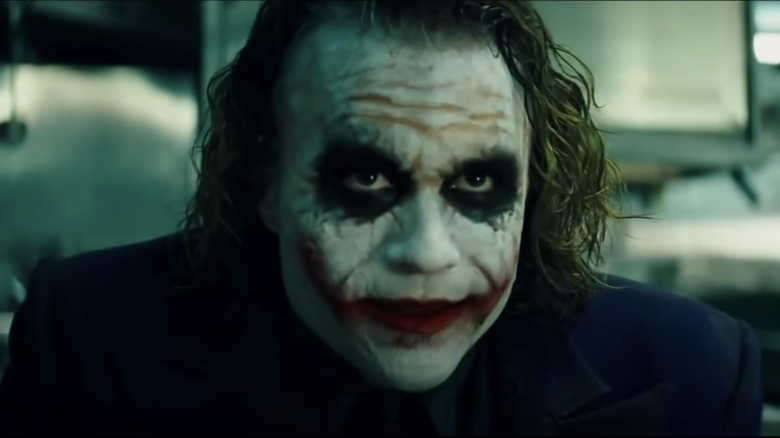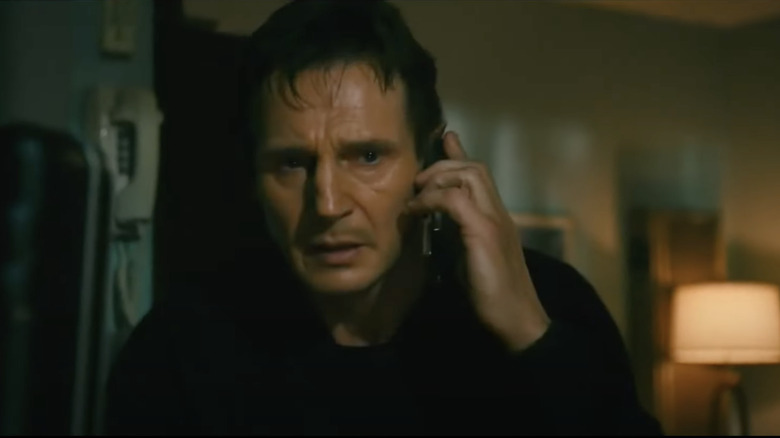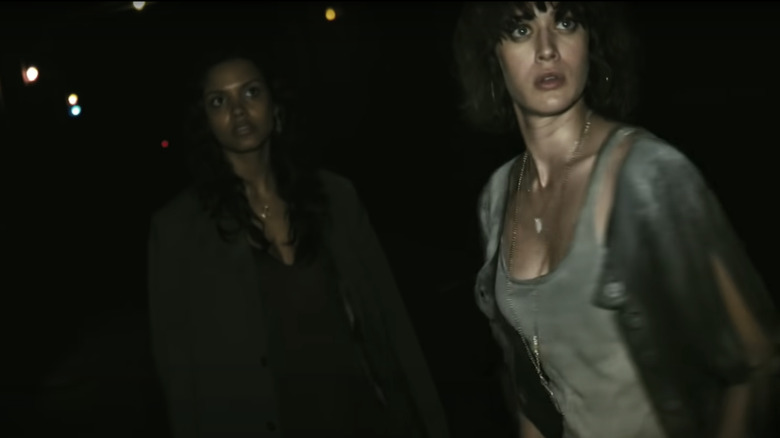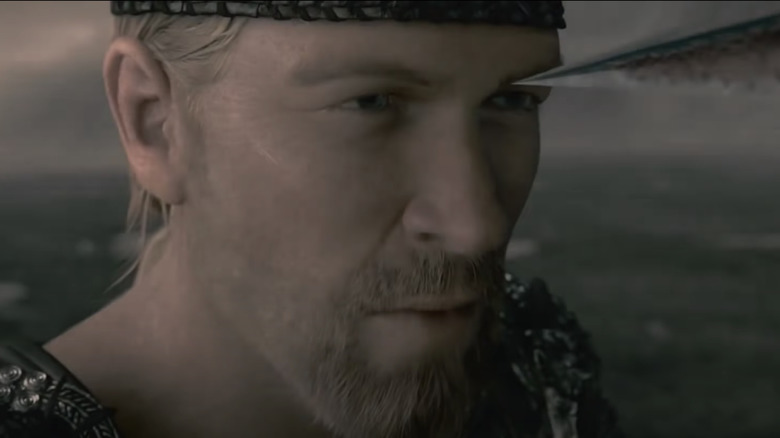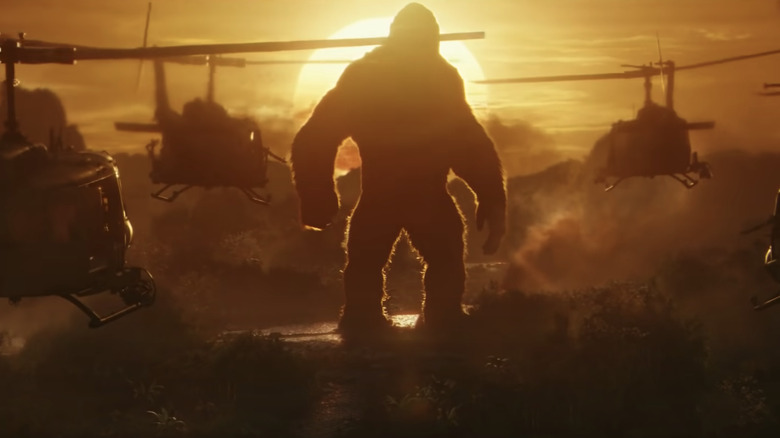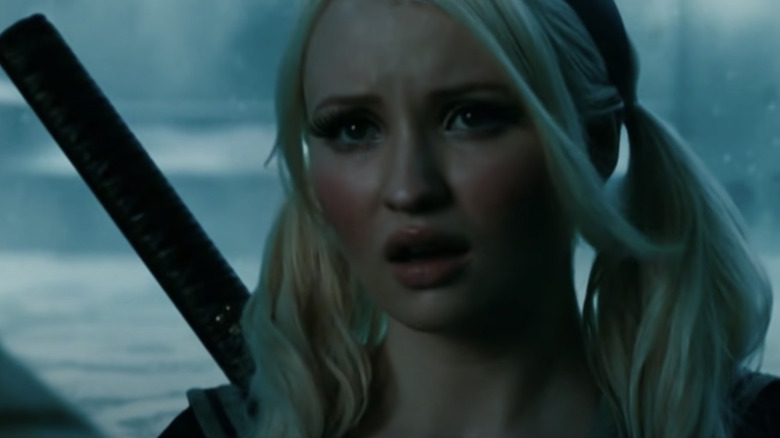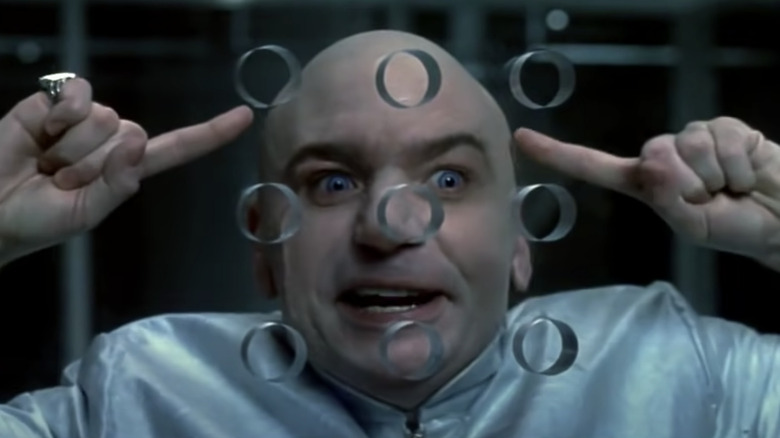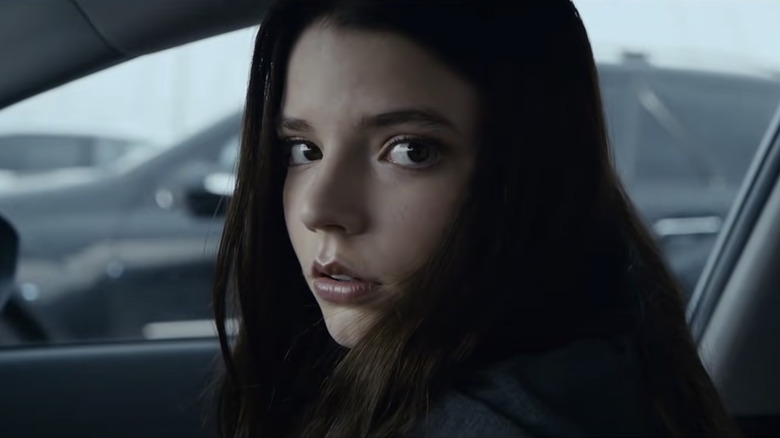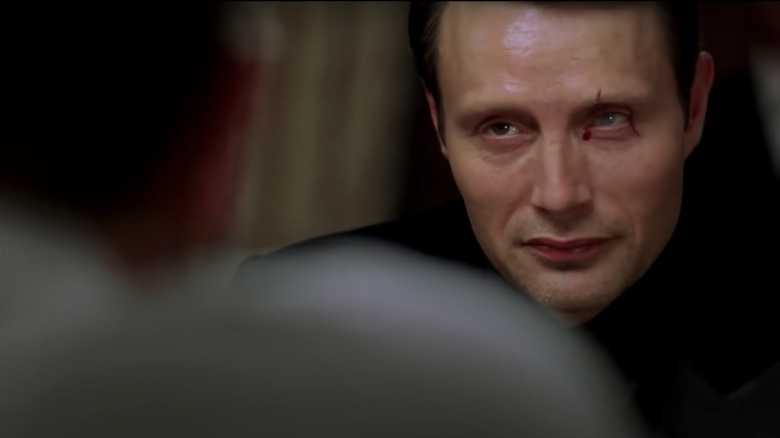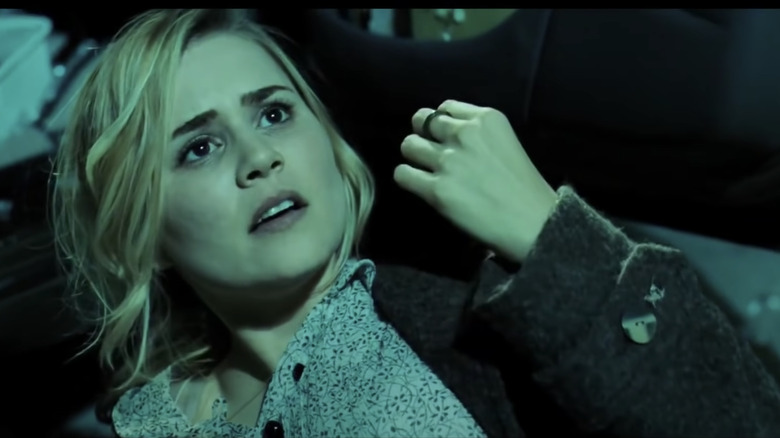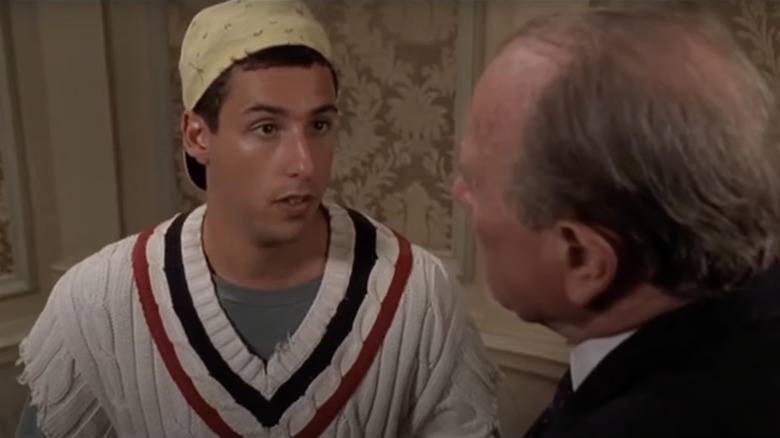The Most Inappropriate PG-13 Movies Of All Time
The '80s cover arguably the best film decade of all time: "Back to the Future," "The Empire Strikes Back," and "Indiana Jones and the Raiders of the Lost Arc." Frankly, George Lucas and Steven Spielberg created a whole era of perfect escapism with wild fantasy and pulpy science-fiction films. Yet, in this mess of movie magic, some shocking scenes have modern viewers wondering just what the MPAA was thinking.
The PG-13 movie rating is relatively new, only instated in 1984 after a slew of violent and terrifying films were released to an unsuspecting pack of '80s youngsters. Even now, adults may wish to revisit childhood favorites and walk away wondering how their parents ever let them watch said film in the first place ("Chucky" nightmares, anyone?).
Unsurprisingly, "Gremlins" and "Indiana Jones and the Temple of Doom" were two films that led to the creation of the PG-13 rating. This was due to complaints from parents and critics about the gruesome violence in "Temple of Doom" and, let's face it, the incredibly creepy little monsters in "Gremlins." Steven Spielberg was involved with both films and agreed with the parental outcry, so he encouraged the MPAA to come up with a rating in-between a PG and an R, giving Americans the PG-13 rating (via Hollywood Reporter). However, just because the MPAA created a new rating for these supposed "acceptable for teen audiences" movies doesn't mean every PG-13 film was rated correctly; even some R-rated movies can take things too far.
But it's not all graphic scenes of blood and guts; looking back, many early PG-13 films used racial and ableist slurs, or featured inappropriate scenes of groping and sexual acts, and sexist comments. Listen, we're not here to ruin anyone's favorite nostalgic film ("Goonies" forever), but let's be honest, there are a few films that should never have gotten a PG-13 rating.
That pencil trick shocked the cinematographer
While "The Dark Knight" is amazing and probably one of the best superhero movies of all time, it's also a PG-13 film. Christopher Nolan's gritty installment in the Batman franchise is, without a doubt, brilliant. Heath Ledger as the Joker was one of the actor's best roles, driving Batman to a darker, more complex understanding of himself and the nature of good and evil.
Yet, the film doesn't shy away from violence, even if it isn't particularly bloody. Even Wally Pfister, cinematographer for "The Dark Knight," is shocked the film didn't earn an R rating, as he told Vulture. "It's kind of shocking that 'The Dark Knight' ended up being PG-13. All of Chris's movies would be PG-13 to open it up to a wider audience. Somehow, he always had some magic with the MPAA. Lo and behold, he has the pencil and I'm like, 'You are not getting the PG-13 with that. There's no way this is going in. He's driving this pencil through a guy's head!' And I was wrong." By using the pencil trick as a joke, a punchline to a "magic trick," Nolan and his crew obtained a PG-13 rating.
Taken should definitely have been rated R
This should shock everyone because it blew our minds: 2008's "Taken" is actually PG-13. This action-thriller starring Liam Neeson was a box office star, earning over $226 million worldwide (per Box Office Mojo), launching countless internet memes, and firmly ingraining itself in popular culture.
Frankly, it should also be rated R. "Taken" has shocking violence, including an alarming torture scene that had to be heavily edited for the PG-13 version. The extended "harder cut" features even more graphic violence in this scene when Neeson stabs a man with two metal nails so he can electrocute him. "Taken" also deals with human trafficking, showing moments of hard drug use and implied sexual assault with several female characters.
Even with all the violent hand-to-hand combat scenes and bullets flying everywhere, "Taken" managed to pull off the more financially lucrative PG-13 rating, probably because they kept most of the blood and gore to a minimum. Realistic and extreme portrayals of violence are not acceptable in the MPAA PG-13 rating, so gushing blood is what usually pushes it into R territory.
If you or anyone you know has been a victim of sexual assault, help is available. Visit the Rape, Abuse & Incest National Network website or contact RAINN's National Helpline at 1-800-656-HOPE (4673).
Some of the explosions were a bit unnecessary
The found footage horror genre has always been compelling; who doesn't love a freaky dash of realism in their scary movie? "Cloverfield," the first in a multi-film franchise, premiered in 2008, seemingly just another teen monster movie with too many jump cuts. However, "Cloverfield" was a massive box office hit, bringing in over $172 million worldwide according to Box Office Mojo, and landing on a few "Best Horror Films of the Decade" lists.
Yet, this surprisingly frightening film features more than a few scenes of shocking gore; the gruesome nature of the movie probably should have earned it a higher rating. One scene, in particular, stands out for all-encompassing gore as Marlena (Lizzy Caplan) begins bleeding from the eyes and then, quite literally, explodes.
The film's monster, which isn't shown to the audience until almost halfway through, is the size of a city building, meaning that its favorite thing to do is eat people. Without any concern for our delicate viewer sensibilities, the monster crunches away through a few humans. Usually, this much gore would be enough to put the brakes on a PG-13 rating; however, producer J.J. Abrams somehow managed to keep the teen-friendly rating.
Beowulf made Angelina Jolie uncomfortable
Motion capture became incredibly popular during the early 2000s, and this cinematic interpretation of the ancient English epic poem "Beowulf" uses the technology almost exclusively. Sidenote, Neil Gaiman was one of the main writers (via IMDb). This 2007 film starred Angelina Jolie, John Malkovich, and Anthony Hopkins.
Even though the film is entirely CGI, it's incredibly realistic (minus the dragon and the lizard woman), with critics and viewers wondering after they left the cinema, "Was that Angelina Jolie in the nude or just her character?" It's a scene that Jolie admitted later made her feel exposed, despite its animated classification (via Digital Spy). In fact, Jolie told reporters at the premiere that the film's low rating surprised her: "It's remarkable it has the rating it has. It's quite an extraordinary film, and some of it shocked me."
Beowulf is incredibly violent, much more than its original poem, with spears, arms, heads, blood, and dismembered limbs rushing at the audience. Oh yeah, it was 3D. Did we forget to mention that? The film was so shocking to audiences that in the UK (where the film was considered "12A"), the BBFC film regulator received more complaints about "Beowulf" than any other movie that year (via Metro.co.uk).
Not only did the film feature plenty of nudity and a few incest jokes, but the amount of blood that spurts out of bodies (as well as floating organs) is overwhelmingly gratuitous, animated or not.
The monster-on-monster violence was a bit much
The most surprising deaths in 2017's "Kong: Skull Island" are the soldiers who are both eaten and thrown by a monster, which just feels excessive. The sad fact here is that it's not just the humans subjected to such violent ends, but also a few monsters, including an unfortunate lizard and its forcible tongue removal.
So much of the film is wanton violence and monster dismemberment that any reasonable viewer is left asking, "Dear filmmaker, was that action warranted?" (Jordan Vogt-Roberts directed this monster-slasher flick, please direct all inquiries to him.) However, the shocking display of blood arcing through the jungle (and the time a giant spider impaled a man) wasn't enough to keep audiences from the theater, since it proved fairly popular at the box office (via Box Office Mojo).
For director Vogt-Roberts, however, the violence in the film made sense, since he cited "Apocalypse Now" as one of the main influences of the movie (via Playlist Now). Beyond its shockingly bloody sequences, there's been fair criticism of the film's ethnocentrism, especially since it parallels aspects of the Vietnam War (via Roger Ebert). Regardless, the sight of a man's arm being ripped off usually remains in "Rated R" territory; how "Kong: Skull Island" kept its PG-13 is a mystery.
Sucker Punch is a misogynist fantasy
Director Zack Snyder ("300") created and wrote the 2011 film "Sucker Punch," a video game-style fantasy action film that Snyder marketed as a feminist thriller, a violently-imaginative revenge film for women. The film was universally panned so badly that it "[raised] the bar for what counts as terrible" (via Kotaku), and was a financial failure, barely earning enough to break even on its production budget (via Box Office Mojo).
"Sucker Punch" centers around five women who have been institutionalized in a brothel masquerading as a mental asylum. While horrific acts of constant sexual abuse and assault happen in the asylum, the women retreat to a fantasy world where they kill dragons, slay zombies, and fight every other type of monster, human and imaginary.
Despite the dark themes and graphic scenes of violence, the film managed a PG-13 rating because it kept the blood to a minimum and implied scenes of rape rather than showing them explicitly. The female characters of "Sucker Punch" suffer either humiliation or horrifying abuse at the hands of the men surrounding them. A.O. Scott of the New York Times said of the film, "As they scheme and scream and suffer, the actresses go along with Mr. Snyder's pretense that this fantasia of misogyny is really a feminist fable of empowerment." Ten years later and the film feels even more insensitive and gratuitous.
If you or anyone you know has been a victim of sexual assault, help is available. Visit the Rape, Abuse & Incest National Network website or contact RAINN's National Helpline at 1-800-656-HOPE (4673).
Austin Powers had some troubling scenes
While the three "Austin Powers" films were obviously a product of the '90s, and a popular one at that ("The Spy Who Shagged Me" brought in over $206 million worldwide, per Box Office Mojo), it doesn't excuse the films for having crossed the line multiple times.
The James Bond-Spoof series created by and starring Mike Myers popularized the infamous "Groovy, baby!" line and some questionable fashion choices influenced by the 1960s. However, these PG-13 films haven't aged well, particularly with their many instances of racism, cultural appropriation, and misogyny. For most of the series, women's bodies serve as little more than a punchline, and almost all the female characters are submitted to the constant and aggressive sexual advances of Austin Powers.
In the 2002 sequel, "Austin Powers: Goldmember," two Japanese twins meet Austin Powers, and their names are Fook Mi and Fook Yu. Obviously, a bad choice. Not only is this an inappropriate instance of cultural appropriation (which Kourtney Kardashian carried on by dressing up as one of the twins for Halloween in 2018, per People), but the scenes caused controversy with its derogatory misuse of Asian-sounding names. In the decades since the films' releases, many have criticized the series for contributing to the sexualization of Asian women (via The Washington Post).
The problematic portrayal of mental illness in Split
M. Night Shyamalan's 2016 film "Split," starring James McAvoy, was a scandal from the start. "Split" is a supernatural thriller about three women kidnapped and held by a man with DID, dissociative identity disorder, who has 23 different personalities plus one supernatural personality, "the Beast." Almost immediately, there was a backlash against the film for its portrayal of DID, particularly because it emphasized trauma as a catalyst and furthered the negative stigma about mental illness (via CBR).
Even mental health professionals stepped into the fray, claiming that it was a damaging and inaccurate film, showing DID sufferers as violent abusers and kidnappers (via Healthline). However, its inappropriate characterization of mental illness wasn't the only problematic plotline (spoiler alert ahead). The main protagonist in "Split" is Casey (Anya Taylor-Joy), who has been kidnapped by "the Beast" in his attempt to rid the world of the "impure" (those who have not suffered).
How does Casey escape the clutches of the beast? Because her uncle molested her as a child, she is "pure" in her suffering and is allowed to live. That's right, this shocking message toward survivors of sexual abuse is horrendously inappropriate. The film managed a PG-13 rating since most of the violence, minus a few intense graphic scenes, happens off-screen. These harmful messages and damaging stereotypes weren't meant for young audiences.
If you or someone you know needs help with mental health, please contact the Crisis Text Line by texting HOME to 741741, call the National Alliance on Mental Illness helpline at 1-800-950-NAMI (6264), or visit the National Institute of Mental Health website.
Casino Royale was almost rated R
Some might be surprised to see the blockbuster (and admittedly excellent Bond film), "Casino Royale," on this list, but there are more than a few scenes that call its PG-13 rating into question. In 2006, "Casino Royale" felt like a groundbreaking new take on James Bond (Daniel Craig): It was grittier and more emotional with a Bond struggling with the violence inherent in his role, a self-awareness not seen before in the usually carefree womanizer. It was also a box office smash, earning over $605 million worldwide (via Box Office Mojo).
With the darker themes came more graphic and explicit scenes of violence, particularly in the film's intense portrayal of torture. Towards the end of the film, Bond is captured by Le Chiffre (Mads Mikkelsen) and tortured in a particularly memorable scene. We won't describe it here because, as we said, it's pretty memorable, but audiences might not know that to get its PG-13 rating, that scene and several other fight scenes were cut down. That's right, in the extended editions of the film, Bond's howls of pain carry on for longer, Le Chiffre also makes some unsavory comments about Bond's physique, and the fight scenes are a little more bloody, meaning that Bond barely escaped an R rating.
Drag Me to Hell was too gory
Sam Raimi, a noted horror and noir aficionado, wrote and directed the 2009 film, "Drag Me to Hell." This campy supernatural horror film was mainly marketed as a teen flick, filled with young actors (Alison Lohman and Justin Long), shock-value special effects, and dark humor. And for the most part, "Drag Me to Hell" delivers on that score; however, many of the violent scenes in the film are shockingly bloody.
There are also multiple scenes of animal sacrifice though this mostly happens off-screen, but really, more than one is enough.
The most famous graphic scenes involve an older woman shoving her hand down another woman's throat (and all that implies). How does one stop such a violation? Well, Christine notices an anvil hanging in the shed rafters; releasing the rope that holds it in place, the anvil crushes the old woman's head, causing her eyes to explode out of her face and land in Christine's mouth. Generally, scenes that are this gruesome and bloody would mean an R rating, Raimi's usual horror stomping grounds; however, somehow, Raimi managed to cut a few scenes here and there, allowing him to keep the PG-13 rating he wanted.
Billy Madison hasn't aged well
Adam Sandler has never been accused of high art in his films, happy to reach for the adolescent jokes he's been heaving at audiences for nearly 30 years. Sandler's 1995 "Billy Madison" has achieved cult status, heralded as a "master class in manchild comedy." (Yes, that is a real quote from Rolling Stone.) While the film does have a heartwarming message of never giving up and an impressive cast to deliver it, "Billy Madison" was critically panned, receiving a Metacritic score of 16 out of the maximum possible score of 100.
Here's the thing, though: Cult classic it may be, but there are more than a few comedic gags that haven't aged well, particularly in its attitude toward women. Billy has a "Drunk Chicks" nudie magazine, a name for an adult magazine that doesn't even feel remotely funny today. Similarly, Chris Farley, who plays the bus driver, looks up a teacher's skirt as she boards the bus. And of course, who can forget when a child dares Billy to grab their female teacher's chest, to which he responds, "That's assault, brother," only to raise his eyebrows and ask if he'll double dare him? The child does, and Billy gleefully falls against his teacher, groping her breast.
In 1995, these scenes were considered crass and rude; in today's world, it's uncomfortable to watch; the ick factor of sexual assault and molestation being played out for laughs feels like this PG-13 movie should come with a content warning these days.
If you or anyone you know has been a victim of sexual assault, help is available. Visit the Rape, Abuse & Incest National Network website or contact RAINN's National Helpline at 1-800-656-HOPE (4673).
